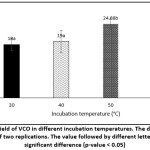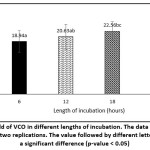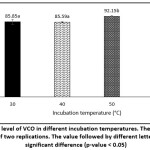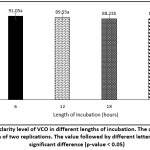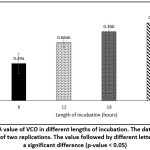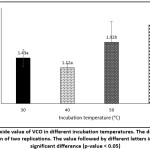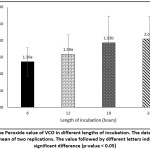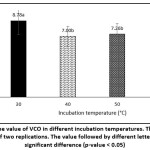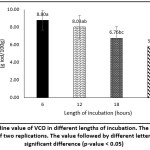Introduction
Virgin coconut oil (VCO) is a pure coconut oil product that is often made from coconuts without heating and with or without the aid of chemicals. It is colourless, liquid, and has a fresh coconut scent.1,2 According to Narayanankutty3, VCO products are widely used in the food industry, including as a frying medium, since they contain saturated fatty acids which are not easily oxidized. VCO is involved in a number of biological processes that are beneficial to human health, including antiviral, antifungal, antiparasitic, antibacterial, cardioprotective, hepatoprotective, antidiabetic, hypolipidemic, anti-inflammatory, and antioxidant.4–8 Several methods that can be used in VCO production include centrifugation, heating fermentation, and enzymatically.9,10
The enzymatic method is very advantageous because enzymes are non-toxic and specific catalytic agents and are produced from natural ingredients, making them environmentally friendly.11 Besides, according to Prayitno12, the enzymatic approach is considered to be the effective way of producing VCO since it avoids damaging essential components by not using severe heating. When making VCO, proteolytic enzymes will accelerate the breakdown of the lipoproteins that cover the oil, causing the oil to bond and create pure coconut oil.13 The enzyme papain is one of the proteolytic enzymes that can be employed. The papain enzyme has some advantages over other proteolytic enzymes, such as having a wider pH range of about 5-7. It is also quite resistant to temperature treatment, with ranges of 50–65 ⁰C.14 Enzyme stability during storage can be maintained by using a maltodextrin coating to protect the active site of the enzyme when in contact with the outside environment. However, in the process of making VCO enzymatically, several things need to be considered to produce high yields and good quality, including temperature and incubation time. Coated and non-coated enzymes could have different optimum incubation temperatures and duration.
Excessive temperature and incubation time can affect the quality of the VCO produced because the use of high temperatures will accelerate oxidation and hydrolysis reactions which will lower the quality of the oil15, while temperatures below the appropriate temperature will result in enzymes not functioning effectively, resulting in a reduction in acquisition of VCO product, so that these two factors are very crucial to pay attention to in the production of VCO.
Several studies that utilize the papain enzyme in the manufacture of VCO include research conducted with variations in temperature treatment with a fixed incubation time of 6 hours, and the result was that 40 ⁰C was the best treatment.13 Research conducted with the treatment of variations in enzyme concentration16, as well as previous research with the treatment of variations in incubation time at room temperature the best results were obtained from the results of incubation for 19 hours17. In this research, the optimum temperature and incubation time in the VCO production using coated crude papain enzyme was determined. The specific objectives of this research including to determine the effect of incubation temperature and length of the coated crude papain enzyme on the yield and quality of the resulting VCO.
Materials and Methods
Materials
The main ingredient used in this research was Coconut with the type of “Kelapa Dalam”, crude papain enzyme, ethanol, phenolphthalein (Merck, Pro Analysis (PA) grade), Sodium Hydroxide (Merck, PA grade), Wij’s solution (Merck, PA grade), Potassium iodide (Merck, PA grade), Sodium thiosulfate (Merck, PA grade), starch, Hydrochloride acid (Merck, PA grade) Acetic Acid (Merck, PA grade) Chloroform (Merk, PA grade) Sodium chloride (Merck, PA grade) demineralized water, aluminium foil, and filter paper Whatman 42.
Crude Papain Enzyme Preparation
The procedure used to manufacture the papain enzyme was followed18, the papaya fruit should first be cleaned before the papaya latex is tapped with a tapping knife to a depth of 1-2 mm. The recovered latex was gathered in a beaker. The latex was then homogenized with a homogenizer to create a white emulsion by combining it with 0.3% sodium chloride (NaCl) activating solution at a ratio of 1:4 (v/v). Filtered again to separate the filtrate from the residue. To create crude papain powder, the residue was first dried at 55 ⁰C in an oven before being crushed and filtered. A yellowish-white tint is a sign of high-quality crude papain. Then, a coating of maltodextrin was performed by mixing maltodextrin and crude papain in a 2:1 ratio.
Grated Coconut Preparation
The preparation of grated coconut followed19 in which the fresh coconut was selected, then opening the husk, shattering the shell, separating the shell from the fruit and using a knife to peel the coconut testa. The obtained fresh fruit flesh is then grated.
Coconut Milk Extraction
Coconut milk extraction was performed with several steps13. Water was first added to the grated coconut in a ratio of 1:1 (w/v). The mixture is then placed into a spinner machine and filtered to obtain the coconut milk. This repeated three times. The extract is then collected, combined, and stirred before being placed in a clear container for around two hours to separate the coconut cream from the skim. The cream is taken as an ingredient for making VCO.
Virgin Coconut Oil (VCO) Production
The production of VCO began by putting 100 ml of coconut cream into a beaker12. After that, 0.5% (w/v) of coated crude papain was added, and then the mixture of coconut milk and papain enzyme was stirred until homogeneous. Furthermore, the beaker was closed and incubated in different incubation duration (6, 12, 18, and 24 hours) at different temperatures (30, 40, 50, and 60⁰C) until three layers were formed, namely at the top, there was coconut cake, the middle part is oil, and the bottom is water. Following the formation of three layers, the water in the bottom layer is removed with the use of a syringe, and the oil and coconut cake are then separated using filters.
Research Design
This research was designed using a Completely Randomized Design (CRD) consisting of two factors; incubation temperature (30, 40, 50, and 60⁰C) and incubation time (6, 12, 18, and 24 hours) with two replications.
Research Parameters
The yield of Virgin Coconut Oil (VCO)
Yield determination of VCO was performed by measuring the volume of coconut cream used20 and measuring the volume of VCO resulted using volumetric glass, and calculated following the formula:
Level of Clarity
Determination of the clarity level 21 begins with preparing samples of oil and demineralized water as blanks. After that, the transmittance was measured using a spectrophotometer with a wavelength of 395 nm. The transmittance value is expressed as the value of the clarity level.
Free Fatty Acid
Determination of free fatty acids (FFA) was carried out by weighing 2 g of oil into an Erlenmeyer and adding 25 ml of hot 95% ethanol and three drops of phenolphthalein (PP) indicator. Following a 30-second homogenization with a magnetic stirrer, the sample solution was titrated with 0.1 N sodium hydroxide (NaOH) solution until the colour turned pink and lasted for approximately 30 seconds. The results obtained are then entered into the following equation.22
Information:
Vol= Volume NaOH used (ml)
N = Normality NaOH (N)
Mw= Molecular Weight of lauric acid
Peroxide Value
Determination of the peroxide value following the method from previous research9 begins by weighing the sample as much as 2 g into the Erlenmeyer. Furthermore, 15 ml of a solvent mixture consisting of acetic acid and chloroform was added in a ratio of 3:2 (v/v). Then 1 ml of saturated Kl solution was added, homogenized, and allowed to stand for 2 minutes. After homogeneous, the mixture was incubated for 30 minutes at room temperature, and then added 15 ml of distilled water and 1 ml of starch solution were used as an indicator. The solution was then titrated with sodium thiosulfate (Na2S2O3) 0.01 N to be colourless. The result was performed in milli-equivalents (meq) peroxide O2 per 1 kg Virgin Coconut Oil (VCO) with the following formula.
Information:
A= Volume of Sodium thiosulfate (ml)
N= Normality of Sodium thiosulfate (N)
g= Sample weight (g)
Iodine Number
The process for calculating the iodine number starts with the addition of 15 ml of chloroform and 25 ml of Wij’s solution to a 0.5 g sample that has been weighed into an Erlenmeyer. After homogenization, the sample is then kept in a dark environment for 30 minutes. Then, 20 ml of 15% KI solution and 100 ml of distilled water were added. Subsequently, the sample was titrated with 0.1 N sodium thiosulfate (Na2S2O3) until the yellow hue disappeared, and then starch solution was added until the sample turned blue. After that, the titration is carried out again until the blue color fades or is colorless. The level of iodine number is then calculated based on the following equation.9
Information:
Vb= Volume of natrium thiosulfate in blank titration (ml)
Vs= Volume natrium thiosulfate in sample titration (ml)
N= Normality of natrium thiosulfate
M= Sample weight (g)
Water Content
Water content was determined by drying an empty porcelain cup for 1 hour (105 ⁰C), then weighing 2 g of the sample in the dried porcelain cup that previously had been weighed. After that, the samples were placed in the oven for 3 hours at 105⁰C. Then, it was cooled in a desiccator for 15 minutes and weighed. This treatment was repeated until the sample weight difference was no more than 0.05 mg or constant. After being constant, the weighing results are entered in the following equation.23
Data Analysis
All data obtained in this research were analyzed with Analysis of Variance (ANOVA). The difference was tested with Duncan Multiple Range Test (DMRT). The application applied was SPSS 16.0 and Microsoft Excel 2019.
Results and Discussion
Yield (%)
The yield of Virgin Coconut Oil (VCO) defines as the percentage of VCO results per coconut cream used.24 It is expected that the yield will be higher in the incubation temperature of 50 and 60⁰C as it is the optimum temperature for the papain enzyme and that the yield will be higher with the higher incubation time. The yield obtained in this research ranged between 18-24.88%. Statistical analysis showed that both incubation time and temperature showed significant differences (p<0.05) in the yield results. The yield of VCO in different incubation temperatures and lengths is presented in Figures 1 and 2, respectively.
In Figure 1, it can be seen that a higher temperature gives a higher yield. The application of 50 and 60⁰C shows a yield was significantly higher than the yield in the VCO with the incubation temperature of 30 and 40⁰C. The maximum yield obtained in the application of 50 and 60⁰C was due to the optimum temperature of the enzyme that works optimal in the temperature range of 50-60⁰C25. Up to the optimum temperature, enzyme activity will rise, but temperatures over that point will inhibit enzyme activity and may even damage the enzyme26. The yield obtained in this study was slightly higher than the yield of VCO obtained in a previous study 13, where it was found that the average yield gain at crude papain concentrations of 1.0; 1.5; and 2.0% for the treatment at 40 ⁰C was 17.23%, 45 ⁰C was 17.21%, and 50 ⁰C was 17.13%.
Figure 2 demonstrated that there was a tendency for the yield to rise as incubation time increased. This is because the papain enzyme works longer to hydrolyze the lipoprotein in the oil emulsion; thus, the oil yielded was maximum. This result is consistence with research in which the longer the incubation, the more breaking activity to produce oil in greater quantities17. The yield obtained in this study was similar to the yield obtained in a previous study 17 with the addition of commercial papain enzyme treatment of 0.01; 0.015; 0.02; 0.025; and 0.03 g/ml obtained an average yield at 14 hours of incubation of 9.01%, 16 hours of 17.16%, 18 hours of 21.2%, 20 hours of 24.5%, 22 and 24 hours of 26.1%.
Clarity Level (%)
The degree of clarity is a parameter resulting from the transmittance percentage (%T) or the amount of light that is transmitted or passes through the oil.27 The degree of clarity can be measured using a spectrophotometer at a wavelength of 395 nm using demineralized water as a blank.28 The transmittance percentage indicates that the higher the %T value, the clearer the VCO produced.21 Based on the results of observations for all treatment combinations, the degree of clarity (%) was obtained in the range of 85.59-93.29. The statistical test revealed that the incubation temperature treatment and the incubation time treatment had a significant effect (p <0.05) on the degree of clarity of the resultant VCO. The clarity level of VCO in different incubation temperatures and lengths are presented in Figures 3 and 4, respectively.
Figure 3 shows a tendency to increase in the value of the degree of clarity as the incubation temperature increases. The result showed that the application of 50 and 60⁰C of incubation temperature shows a higher value of clarity level and is significantly higher compared to VCO with the application of 30 and 40⁰C of incubation temperature. This is because the separated proteins in the emulsion have coagulated at high temperatures so that the protein layers do not mix with the VCO emulsion.29 In addition, the papain enzyme, which works at the optimum temperature, will cause a more optimal separation of lipoproteins from oil. The low level of clarity (%) of VCO at 30 and 40 ⁰C is due to the influence of the protein content which has not been completely separated from the oil 30.
Figure 4 shows a tendency to decrease the degree of clarity as the incubation time increases. The incubation time treatment of 6 and 12 hours was significantly different from the 18- and 24-hour incubation time treatment. The shrink in the clarity level, along with the incubation time, is due to the hydrolysis process that occurs during incubation. This results inbound water in the VCO, thereby reducing the degree of clarity. Cooking oil that is not clear tends to have undergone a process of hydrolysis.31 The findings of this research align with the research performed by Fikri and Kadir 30, which explains that the longer hydrolysis process will reduce the degree of clarity of VCO.
Free Fatty Acids (FFA, %)
Free Fatty Acids (FFA) is one indicator that determines the quality of the oil. A high FFA value indicates a decrease in oil quality, which indicates the amount of acid released in the oil hydrolysis process.32 Based on observations for all treatment combinations, FFA data were obtained in the range of 0.4-0.84%. The statistical test results showed that the incubation time treatment had a significant effect (p<0.05) on the resulting VCO FFA. The FFA value of VCO in different lengths of incubation is presented in Figure 5.
Figure 5 shows that there is a tendency for the FFA value to increase as the incubation time increases. The 18 and 24-hour incubation duration shows significantly higher FFA value than the FFA of VCO after 6 hours of incubation. The FFA value resulting from VCO in this research did not meet the ICC standard 33, in which the maximum FFA in VCO is set to 0.2%. The high levels of free fatty acids obtained and the increase in FFA levels with the length of incubation time were due to the fact that during the incubation process, there was direct contact between the oil and water layers, which resulted in hydrolyzed oil. This explanation is supported by the reason that the contact of oil with water will cause a complex degradation reaction in the oil to produce a free fatty acid. 34 The findings of this research show that the performing of refinement, like with the application of zeolite adsorbent 35 is necessary to decrease the FFA value of VCO result and further increase the quality.
Peroxide Value (meq/kg)
Peroxide number is an index of the amount of oil that has undergone an oxidation process or binds oxygen to form peroxide on the double bond or unsaturated fatty acids in the oil.2 The peroxide number is related to the quality of oil as it can cause rancidity. A broken double bond will result in the formation of short-chain fatty acid bonds and volatile compounds, which result in a rancid smell32. Besides, this reaction will cause the destruction of oil-soluble vitamins such as vitamins A, D, E and K. The process of oxidation of oil by oxygen can occur spontaneously when in direct contact with air, which will be accelerated as the temperature increases.15 In addition, in the enzymatic method production process, the incubation time will affect the oil oxidation process, which will affect the VCO peroxide value.
Based on observations for all treatment combinations, peroxide number data were obtained in the range of 1.12-2.05 meq/kg. Statistical analysis indicates that incubation temperature and length significantly affect (p<0.05) the peroxide value of VCO resulted. The peroxide value of VCO in different incubation temperatures and lengths are presented in Figures 6 and 7, respectively.
Figure 6 shows a tendency to increase the peroxide value as the incubation temperature increases. The peroxide value of VCO with the incubation temperature of 60 ⁰C was significantly higher than the peroxide value of VCO incubated at 30, 40, and 50 ⁰C. All the temperatures applied, however, produced VCO that had met the ICC standard 33 with a maximum of 3 meq/kg peroxide number. The high peroxide number in high temperatures was caused by the fact that the higher temperature will trigger an oxidation reaction faster and maximally that it reaches a higher number in peroxide number. Oil oxidation occurs spontaneously when oil is exposed to air and even faster with the presence of high temperature, light, and oxygen. 15
Figure 7 shows that there is a tendency for the peroxide value to increase as the incubation time increases. It can be pictured from the figure that the peroxide value of VCO in 18 and 24 h length of incubation is significantly higher than those incubated for 6 and 12 hours. The peroxide analysis revealed that 6, 12, and 18 hours of fermentation of incubation of VCO resulted in VCO that met the standard set by ICC 2021 standard (3 meq/kg).33 The higher number of peroxides, along with the longest time of incubation, was suspected to be caused by hydrolysis. The hydrolysis process can occur during the incubation process, where the oil layer contacts the water and trigger the hydrolysis process. According to Pramitha and Juliadi 36, the longer the hydrolysis process, the higher the peroxide produced.
Iodine Value (g iodine/100g)
The iodine number indicates the degree of unsaturation or the structure of the double bond in the fatty acid.37 The more the amount of iodine measured, the more unsaturated fatty acid content in the oil, which indicates the better quality of the oil.38 The amount of iodine is expressed as the number of grams of iodine absorbed by 100g of oil.9
Based on the results of observations for all treatment combinations, data on iodine numbers were obtained in the range of 5.78-8.80 g iodine/100 g. Statistical analysis indicated that incubation temperature and length significantly affected the iodine value of the VCO produced. The iodine value of VCO in different incubation temperatures and lengths are presented in Figures 8 and 9, respectively.
Figure 8 demonstrates a tendency for the iodine number to decline with rising incubation temperature. The iodine numbers found in all treatments have met ICC standards33 regarding the quality standard for VCO, with number of iodine ranging from 4.1-11 g iodine/100 g. The statistical result reveals that the treatment of the resultant VCO iodine number at 30⁰C was significantly different from the treatments at 40, 50, and 60⁰C. The iodine number in oil can decrease due to the breaking of unsaturated bonds to become saturated due to heating or frying. In addition, one of the parameters related to the iodine number is the peroxide number.39 The formation of peroxides is caused by an oxidation process in the double bonds, which results in a decrease in the number of double bonds or a decrease in the iodine number. Figures 7 and 9, which depict an inverse relationship, show this. This is also emphasized by the previous study that, that there is an inverse
relationship between iodine number and peroxide number. 40
Figure 9 demonstrates a tendency for the iodine number to decline with increasing incubation time that is significantly different based on the statistical analysis. All the Iodine numbers found in all lengths of incubation time in this study have met the standard of ICC33, which iodine value range between 4.1-11 g iodine/100 g. The double-bond hydrolysis process is strongly influenced by the heating time. The longer the heating, the more double bonds or unsaturated fatty acids are broken into single bonds or saturated fatty acids37, which further resulted in a decrease in the iodine number.
Water Content
One of the factors that affect the quality of VCO is water content. This is due to the fact that the low water content will increase the shelf life of VCO by preventing the hydrolysis process, which usually causes rancidity.41 Data on water content were found to be between 0.16 and 0.42% based on observations for all treatment combinations. Statistical analysis showed that incubation temperature, incubation duration, and the interaction between them showed no significant difference (p>0.05) in the water content of VCO. The value obtained for each combination is presented in Table 1.
Table 1: The water content of VCO in different incubation temperatures and lengths.
| Length of incubation | Temperature (°C) | |||||||
| 30 | 40 | 50 | 60 | Average | ||||
| 6 hours | 0.22 | 0.16 | 0.22 | 0.26 | 0.22 | |||
| 12 hours | 0.36 | 0.19 | 0.26 | 0.38 | 0.30 | |||
| 18 hours | 0.30 | 0.22 | 0.29 | 0.35 | 0.29 | |||
| 24 hours | 0.42 | 0.36 | 0.29 | 0.36 | 0.36 | |||
| Average | 0.32 | 0.23 | 0.27 | 0.34 | ||||
The data presented is the mean of two replications.
Table 1 shows the result of the moisture content analysis of produced VCO. It can be seen from the table that the value fluctuated over time and shows no trend in varied temperatures applied. The result shows that most of the moisture values did not meet the ICC standard 33 with a maximum moisture content of 0.1%. This is because the water content contained in VCO is influenced by the method of separating oil between coconut cake and water. The high-water content obtained in certain treatments was caused by the process of separating VCO from water and coconut cake. Separation, in a simple way, causes the water in the bottom layer to come with the oil layer. This is confirmed by Zein et. Al 42, that the difference in water content contained in VCO can occur when the oil, coconut cake and water are separated so that there is still water content which is still included in the oil extraction. This result shows that the VCO produced in this research needs to pass refinement to obtain better quality.
Conclusion
This research concluded that based on the yield of 24.88% and a degree of clarity of 92.15%, the optimal incubation temperature for the production of VCO in this study was 50°C. Based on the yield of 22.56%, 18 hours of incubation was found to be the optimal incubation time for the production of VCO in this study. The peroxide and iodine value findings in this study have met the standard quality for VCO. However, the free fatty acids and moisture content suggest that the VCO produced in this study need a refinement process for quality improvement.
Acknowledgement
The authors would like to express their deepest appreciation to the Study Program of Food Science and Technology, Faculty of Agriculture, Hasanuddin University, for facilitating this study.
Conflicts of Interest
The authors declare no conflict of interest.
Funding Sources
This work was supported by The Ministry of Education, Culture, Research, and Technology of Indonesia (Grant Number 090/E5/PG.02.00/PT/2022).
References
- Selvaraj KV, Bharathi A, Sivakumar V, Karthikeyan A, Maheswarappa H. Virgin coconut oil: A nutraceutical and therapeutic food. Int J Chem Stud. 2020;8(3):662-663. doi:10.22271/chemi.2020.v8.i3h.9282
CrossRef - Natalia A, R DN, Lukmanto F, Ani I, Tarigan IL. Analysis quality characteristics of virgin coconut oil (VCO): comparisons with cooking coconut oil (CCO). Med Lab Anal Sci J. 2019;1(1):30-36. doi:10.35584/melysa.v1i1.20
CrossRef - Narayanankutty A. Health impacts of different edible oils prepared from coconut (Cocos nucifera): A comprehensive review. Trends Food Sci Technol. 2018;80:1-7.
CrossRef - Krishna G, Raj G, Bhatnagar A, Kumar P, Chandrashekar P. Coconut Oil : Chemistry , Production and Its Coconut Oil: Chemistry , Production and Its Applications -A Review. Indian Coconut J. 2010;(July):15-27.
CrossRef - Salian V, Shetty P. Coconut oil and virgin coconut oil: An insight into its oral and overall health benefits. J Clin Diagnostic Res. 2018;12(1):ZE01-ZE03. doi:10.7860/JCDR/2018/31409.11051
CrossRef - Rohyami Y, Hidayat H, Rizky Wijaya A, Fatimah I. Papain Enzyme Assisted Extraction of Virgin Coconut Oil as Candidate In-House Reference Material. Processes. 2022;10(2). doi:10.3390/pr10020315
CrossRef - Jack KS, Asaruddin MR Bin, Bhawani SA. Pharmacophore study, molecular docking and molecular dynamic simulation of virgin coconut oil derivatives as anti-inflammatory agent against COX-2. Chem Biol Technol Agric. 2022;9(1):1-26. doi:10.1186/s40538-022-00340-0
CrossRef - Girish MS, Bhaskaran RM, Bhojraj N, Devraj IM. Evaluation of Antimicrobial Efficacy of Coconut Oil and Low-fluoride Mouthwashes against Streptococcus mutans in Children: A Comparative Clinicomicrobiological Study. World J Dent. 2022;13(6):562-567. doi:10.5005/jp-journals-10015-2115
CrossRef - Ghani NAA, Channip AA, Chok Hwee Hwa P, Ja’afar F, Yasin HM, Usman A. Physicochemical properties, antioxidant capacities, and metal contents of virgin coconut oil produced by wet and dry processes. Food Sci Nutr. 2018;6(5):1298-1306. doi:10.1002/fsn3.671
CrossRef - Soo PP, Ali Y, Lai OM, et al. Enzymatic and Mechanical Extraction of Virgin Coconut Oil. Eur J Lipid Sci Technol. 2020;122(5):1-13. doi:10.1002/ejlt.201900220
CrossRef - Harimurti S, Rumagesan RM, Susanawati. Environmentally friendly production method of virgin coconut oil using enzymatic reaction. IOP Conf Ser Mater Sci Eng. 2020;874(1). doi:10.1088/1757-899X/874/1/012004
CrossRef - Prayitno S. The Physical and Chemical Properties of Virgin Coconut Oil (VCO) Product Obtained Through Fermentation and Enzymatic. Food Sci Technol J. 2019;2(1):1-6.
- Perdani CG, Pulungan MH, Karimah S. Pembuatan Virgin Coconut Oil ( VCO ) Kajian Suhu Inkubasi dan Konsentrasi Enzim Papain Kasar Virgin Coconut Oil ( VCO ) Production : Incubation Temperature and Crude Papain Enzyme Concentration. J Teknol dan Manaj Agroindustri. 2019;8(3):238-246.
CrossRef - Anggraini R, Elfidiah, Kalsum U. Pemanfaatan Daun Pepaya Sebagai Enzim Papain Secara Ekstraksi dengan Penambahan Na-Bisulfit untuk Meningkatkan Mutu Minyak Kelapa (VCO). J Distilasi. 2019;4(1):17-20. doi:10.32502/jd.v4i1.2214
CrossRef - Nurhasnawati H, Supriningrum R, Caesariana N. Penetapan Kadar Asam Lemak Bebas dan Bilangan Peroksida pada Minyak Goreng yang Digunakan Pedagang Gorengan di Jl. A.W Sjahranie Samarinda. J Ilm Manuntung. 2017;1(1):25-30. doi:10.51352/jim.v1i1.7
CrossRef - Iskandar A, Ersan, Edison R. Pengaruh Dosis Enzim Papain terhadap Rendemen dan Kualitas Virgin Coconut Oil (VCO). J Agro Ind Perkeb. 2015;3(2):82-93.
- Andaka G, Fitri K. Pengambilan Minyak Kelapa dengan Menggunakan Enzim Papain. Pros Semin Nas XII Rekayasa Teknol Ind dan Inf. Published online 2017:453-458.
- Silaban R, Hutapea V, Mannulang R, Alexander IJ. Pembuatan Virgin Coconut Oil (VCO) Melalui Kombinasi Teknik Fermentasi dan Enzimatis Menggunakan Ekstrak Nenas. J Kim. Published online 2014:56-64.
- Mohammed NK, Samir ZT, Jassim MA, Saeed SK. Effect of different extraction methods on physicochemical properties, antioxidant activity, of virgin coconut oil. Mater Today Proc. 2021;42:2000-2005. doi:10.1016/j.matpr.2020.12.248
CrossRef - Rindawati, Perasulmi, Kurniawan EW. Studi Perbandingan Pembuatan Vco (Virgin Coconut Oil) Sistem Enzimatis Dan Pancingan Terhadap Karakteristik Minyak Kelapa Murni Yang Dihasilkan. Indones J Lab. 2020;2(2):25-32. doi:10.22146/ijl.v2i1.54196
CrossRef - Laga A, Djalal M, Zainal, Sitorus RZS. Variation of filter media type and thickness combination for coconut oil filtration. IOP Conf Ser Earth Environ Sci. 2019;343(1). doi:10.1088/1755-1315/343/1/012074
CrossRef - Sulo L mariance, Khairuddin, Ruslan. Kemampuan Adsorbsi Abu Sekam Padi Terhadap Air Dan Asam Lemak Bebas Virgin Coconut Oil (VCO) Dalam Kolom Adsorbsi. KOVALEN J Ris Kim. 2019;5(2):121-131. doi:10.22487/kovalen.2019.v5.i2.10115
CrossRef - Zulfadli T. Kajian Sistem Pengolahan Minyak Kelapa Murni (Virgin Coconut Oil) dengan Metode Pemanasan. Int J Nat Sci Eng. 2018;2(1):34-41. doi:10.23887/ijnse.v2i1.13911
CrossRef - Patil U, Benjakul S. Coconut Milk and Coconut Oil: Their Manufacture Associated with Protein Functionality. J Food Sci. 2018;83(8):2019-2027. doi:10.1111/1750-3841.14223
CrossRef - Elsson M, Wijanarko A, Hermansyah H, Sahlan M. Michaelis-Menten Parameters Characterization of Commercial Papain Enzyme “paya.” IOP Conf Ser Earth Environ Sci. 2019;217(1). doi:10.1088/1755-1315/217/1/012037
CrossRef - Yana R, Permatasari S. Pembuatan Isolat Papain Dari Getah Buah Pepaya Untuk Hidrolisis Protein Pada Pengembangan Metode Penambahan Materi Praktikum Biokimia. J Kedokt dan Kesehat Publ Ilm Fak Kedokt Univ Sriwij. 2022;9(2):143-152. doi:10.32539/jkk.v9i2.16806
CrossRef - Mulyan A, Alam N. Sifat Fisikokimia dan Sensoris Minyak Kelapa Tradisional pada Berbagai Konsentrasi Abu Sekam Padi. Agrotekbis. 2022;10(3):554-562.
- Sitorus RZS, Djalal M, Zainal, Laga A. Coconut oil purification using two different concentrations of activated charcoal. IOP Conf Ser Earth Environ Sci. 2020;575(1). doi:10.1088/1755-1315/575/1/012226
CrossRef - Biki MN, Harun NI, Zimiyanti KR, Hasan W, Alamri AR. Pendampingan Pembuatan VCO (Virgin Coconut Oil) di Desa Lelato Kec. Sumalata Kab. Gorontalo Utara. J Pengabdi Kpd Masy. 2020;2(2):1-9.
- Fikri, Kadir S. Kuantitas dan Kualitas Virgin Coconut Oil dari Berbagai Konsentrasi Sari Buah Pepaya (Carica Papaya L). E-Journal Agrotekbis. 2020;8(5):1160-1173.
- Sugesti AM, Rulen BN, Fitria E. Analisa Efektivitas Penyerapan Asam Lemak Bebas pada Minyak Jelantah Menggunakan Ampas Tebu. J Kesehat Maharatu. 2020;1(1):1-9.
- Oseni NT, Fernando W, Coorey R, Gold I, Jayasena V. Effect of extraction techniques on the quality of coconut oil. 2017;11(March):58-66. doi:10.5897/AJFS2016.1493
CrossRef - ICC. ICC Quality Standard Virgin Coconut Oil. Int Coconut Community. Published online 2021.
- Mardiah I, Puspitaningrum K, Hamdani S, Setiani NA. Utilization of Waste Frying Oil as A Source of Carbon in The Production of Biosurfactant using Exiguobacterium profundum. Nusant Sci Technol Proc. 2022;2022(2017):27-33. doi:10.11594/nstp.2022.2104
CrossRef - Palilingan SC, Pungus M. Produksi enzimatis Virgin Coconut Oil (VCO) dengan enzim bromelin serta pemurniannya menggunakan adsorben zeolit. Fuller J Chem. 2018;3(2):70-74. doi:10.37033/fjc.v3i2.41
CrossRef - Pramitha DAI, Juliadi D. Pengaruh Suhu terhadap Bilangan Peroksida dan Asam Lemak Bebas pada VCO (Virgin Coconut Oil) Hasil FERMENTASI. Indones E-Journal Appl Chem. 2019;7(2):149-154.
- Patil U, Benjakul S, Prodpran T, Senphan T, Cheetangdee N. Characteristics and quality of virgin coconut oil as influenced by maturity stages. Carpathian J Food Sci Technol. 2016;8(4):103-115.
- Dewi MTI, Hidajati N. Peningkatan Mutu Minyak Goreng Curah Menggunakan Adsorben Bentonit Teraktivasi. Chemistry (Easton). 2012;1(2):47-53.
CrossRef - Sari SA, Putri TR, AR MR. Effect of Dragon Fruit Juice Addition on Changes in Peroxide Numbers and Acid Numbers of Used Cooking Oil. Indones J Chem Sci Technol. 2019;2(2):136. doi:10.24114/ijcst.v2i2.15449
CrossRef - Maryam YA, Lestari I, Rahayuningsih CK. Penambahan Pelarut Etanol dan Aquadest pada Ekstrak Kayu Secang (Caesalpinia sappan L.) terhadap Bilangan Peroksida dan Bilangan Iodium Minyak Goreng Curah. Pros Semin Nas 2020. Published online 2020:1-6.
- Dumancas GG, Viswanath LCK, Leon ARD, Ramasahayam S, Maples R, Koralege RH. Health Benefits of Virgin Coconut Oil. Nov Sci Publ Inc. 2016;(January):161-193.
- Zein M, Nuryati N, Ilmannafian AG, Lestari E. Analisis Mutu Minyak Pangan dari Biji Karet (Havea brasiliensis) dengan Mengadopsi Metode Pembuatan Minyak Kelapa Tradisional. J Teknol Agro-Industri. 2021;8(1):65-76. doi:10.34128/jtai.v8i1.137
CrossRef

This work is licensed under a Creative Commons Attribution 4.0 International License.







